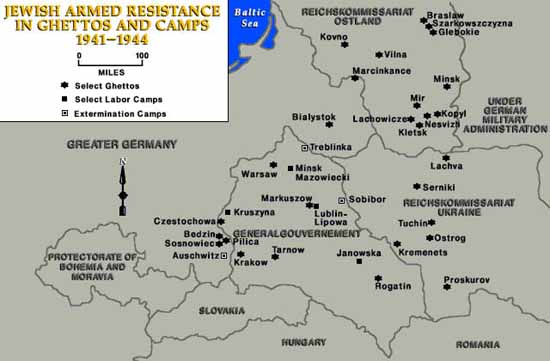The Warsaw
ghetto uprising inspired revolts in other ghettos and in killing
centers. Although many resisters knew they were bound to lose against
overwhelmingly superior German forces, they chose to die fighting.
 After
the last Jews deported to Treblinka were gassed in May 1943, about 1,000 Jewish prisoners remained in the
camp. Aware that they were soon to be killed, the prisoners decided
to revolt. On August 2, armed with shovels, picks, and a few weapons
stolen from the arms warehouse, they set fire to part of the camp and
broke through its barbed-wire fence. About 200 prisoners managed to
escape, and about half of them survived German efforts to recapture
them.
After
the last Jews deported to Treblinka were gassed in May 1943, about 1,000 Jewish prisoners remained in the
camp. Aware that they were soon to be killed, the prisoners decided
to revolt. On August 2, armed with shovels, picks, and a few weapons
stolen from the arms warehouse, they set fire to part of the camp and
broke through its barbed-wire fence. About 200 prisoners managed to
escape, and about half of them survived German efforts to recapture
them.
Two inmates of Sobibor,
Aleksandr Pechersky and Leon Feldhendler, planned a similar revolt in
1943. On October 14, prisoners killed eleven camp guards and set the
camp on fire. About 300 prisoners escaped, but many were killed
during the manhunt that followed. Fifty were alive at the war's end.
At Auschwitz-Birkenau,
prisoners of the Sonderkommando -- the special squad whose job it was
to burn the corpses of the murdered victims -- learned of the plans
to kill them. On October 7, 1944, a group of them rebelled, killing
three guards and blowing up the crematorium. Several hundred
prisoners escaped, but most were later recaptured and killed. Four
young women accused of supplying the dynamite were hanged in front of
the remaining inmates. One of them, 23-year-old Roza Robota, shouted
"Be strong, have courage," as the trap door opened.